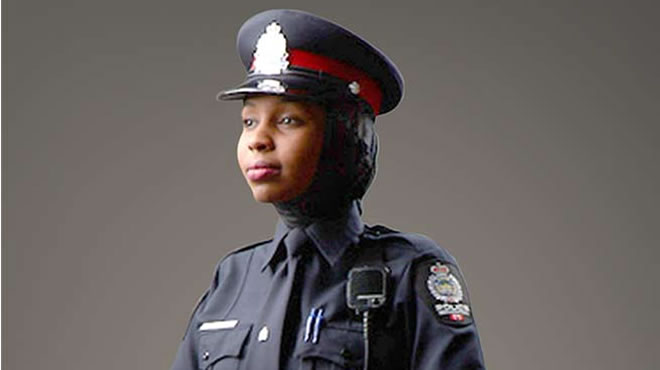
Coleman backs head-scarf ban for Columbus police officers
Columbus Mayor Michael B. Coleman said he supports Police Chief Kim Jacobs' decision to keep officers from wearing head scarves for religious reasons. But he said the city will try harder to recruit immigrants to the force, including by appealing to the families of potential applicants.

"I’ve said this to our chief and safety director, to step up our efforts in this area,” Coleman said in an interview last week. "I strongly believe that our police force needs to be reflective of every corner of our city.”
The issue came to the forefront after The Dispatch wrote in April about Ismahan Isse, a Somali-American and Muslim woman who left the Columbus police academy in March because of the head-scarf ban.
Isse said at the time that her scarf, or hijab, is important to her identity. She said she would like to return to the academy because her dream has been to become a police officer.
Columbus police leaders said in June that they would keep the head-scarf prohibition because they want the division to be perceived as a nonpolitical, nonreligious organization and that the uniform should reflect that neutrality. Officials also said that scarves could pose safety problems.
"When officers go out into the community, they should be identified as Columbus police officers, not Muslim police officers, not Christian police officers, not Jewish police officers, not Hindus, Baptists or anything else,” Coleman said.
Jacobs agrees. "I want whoever pulls up to the scene as being recognized as a Columbus police officer that doesn’t turn anyone off,” she said.
Officers are allowed to wear religious jewelry, such as a cross necklace, as long as it is under a shirt and cannot be seen, said Sgt. Rich Weiner, Columbus police spokesman.

PHOTO COURTESY OF EDMONTON, ALBERTA, POLICE
A model wears a special Edmonton Police Service uniform with a hijab, or head scarf.
That city officials are even talking about the issue is an important first step, said Imran Malik, chairman of the board that oversees the Noor Islamic Cultural Center in Hilliard.
"Maybe the police chief is right, and it is not time to make the change right away, but having a discussion might be the first in a series of baby steps to change.”
Malik said Columbus is more proactive than many other cities in trying to bring cultures and faiths together.
At the same time, allowing police officers to wear a head scarf or other religious attire might go a long way toward helping the city attract more minority recruits, he said.
It also probably would help immigrants and refugees, especially from countries where law-enforcement agencies often are corrupt, feel more comfortable talking to Columbus officers, Malik said.
But Malik also understands the Police Division’s desire to be seen as unified.
"I just hope we keep talking about it because we have to find more ways to be inclusive; that’s the beauty of America,” he said.
Other North American cities have made accommodations for head scarves and other headwear, including Edmonton, Alberta, which has designed a uniform with a hijab. In February, the sheriff in Harris County, Texas, said a Sikh officer would be allowed to wear his faith’s traditional turban and beard.
Columbus officials have pointed to case law to support their decision: A 2007 federal ruling in Philadelphia said that city’s police department did not violate the civil rights of a Muslim officer when it forbade her to wear a head scarf.
Coleman said he views himself as progressive on issues of diversity in the community, and he thought carefully about the issue. But if the city allows one type of religious clothing, it has to allow everything, he said.
Jacobs agreed and said: "If it’s a head scarf next week, it might be a burqa the next week. There’s no legal way our advisers can stop that from happening.”
Hassan Omar, who leads the Somali Community Association of Ohio, said he would like to see the Police Division allow head scarves, but he’s more interested in seeing Columbus make a concerted effort to hire more minority candidates.
The Minneapolis-St. Paul area, which has the largest Somali population in the U.S., has nearly a dozen Somali-American police and transit officers. Columbus ranks second in Somali population with an estimated 40,000.
"It’s an honor to be a police officer, and many young Somali men and women want to serve but aren’t given a chance or encouraged to apply,” Omar said.
Coleman said the city will hold a recruitment expo next year geared toward immigrant communities.
"The end game is to get more new Americans to apply (through) the recruiting process and ultimately become officers,” he said.
The Police Division also has been trying to recruit more officers from minority groups, Jacobs said. She estimated that African-American officers are 12 percent of the force.
She did not have a number for foreign-born officers because the city doesn’t track that information. All applicants must be U.S. citizens, she said.
The city also plans to talk to families of potential applicants to promote the benefits of becoming an officer, Jacobs said.
"It’s a difficult job,” she said. Applicants "need to know they have family support.”



 0
0 






Coleman backs head-scarf ban for Columbus police officers
Columbus Mayor Michael B. Coleman said he supports Police Chief Kim Jacobs' decision to keep officers from wearing head scarves for religious reasons.